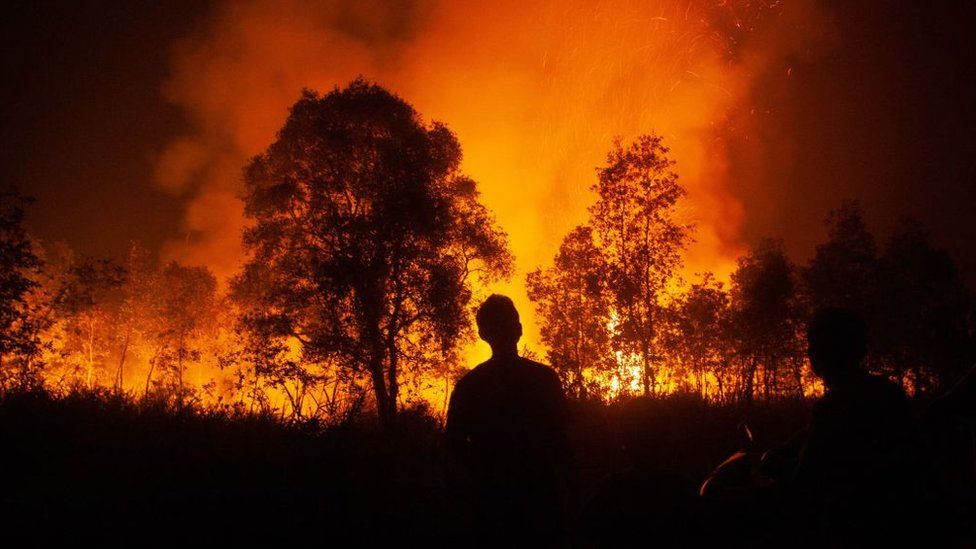Carbon emissions threaten 1.5C climate threshold sooner than thought - report
- Published

Human fossil fuel emissions are threatening a key climate threshold more quickly than previously thought, a new report says.
Researchers say the world may be committed to breaching the 1.5C limit by 2029, rather than the mid 2030s.
They say record average emissions of carbon dioxide over the past three years are a key factor.
They also point to a having a better understanding of how the burning of fossil fuels affects the atmosphere.
After a year of unprecedented heat, with the world's hottest month recorded in July, temperatures for 2023 as a whole are expected to be close to 1.5C above the pre-industrial level, before the world first started heavily using coal, oil and gas around 1850.
While this may be a one off, scientists are worried that soon the world will have emitted enough greenhouse gases to keep temperatures at this level for far longer.
Scientists say that increasing levels of carbon dioxide and other gases in the atmosphere raise temperatures because they trap in the earth's radiation, creating a greenhouse effect.
The 1.5C figure is a key component of the promises made by political leaders when they signed the Paris climate agreement in 2015.
They undertook to keep the rise in global temperatures "well below" 2C and make their best efforts to keep that increase under 1.5C this century.
The 1.5C figure is seen as particularly important for developing states and small island nations, who fear that going beyond this level of warming would see the oceans rise to swallow their homes.
To work out how long it will take the world to reach this key figure, scientists calculated a "budget" of how much carbon can still be emitted before this important threshold is breached.
Earlier this year, the Intergovernmental Panel on Climate Change, the UN's key advisory body, projected that the world could only emit another 500bn tonnes of carbon and have a 50% chance of keeping warming under the 1.5C figure.
As the current annual level of emissions is around 40bn tonnes, the IPCC projected that the threshold would be crossed permanently by the middle of the next decade.
But this new analysis suggests it will be much sooner than that.
The researchers looked at the fact that the IPCC only included data up to 2020, so they adjusted the budget downwards to account for the carbon used over the last three years.
They also re-examined the role of other, non-carbon factors that impact warming.
One of the most critical are sooty particles called aerosols, which mainly arise from the burning of fossil fuels.
They contribute heavily to air pollution but have an unexpected benefit for the climate because they help cool the atmosphere by reflecting sunlight back into space.
The new research paper finds that these aerosols have in fact a far higher cooling impact than previously thought.
But as the world strives to clean up dirty air in cities and to use less of the most heavily polluting fossil fuels, the number of aerosols in the atmosphere declines - meaning temperatures go up faster than previously thought.
The researchers say this new understanding of the role of aerosols removes 100bn tonnes from the remaining 1.5C budget. Combined with the extra carbon and some other small adjustments, this brings the total remaining budget down to 250bn tonnes.
"The window to avoid 1.5C of warming is shrinking, because we continue to emit and because of our improved understanding of atmospheric physics," said lead author Dr Robin Lamboll from Imperial College London.
"We now estimate that we can only afford to release about six years worth of current emissions before we are likely to exceed this key Paris agreement reference point."
According to the researchers, if the world is to avoid going over 1.5C, global emissions of carbon dioxide would have to reach net zero by 2034, not 2050 as is currently the expectation.
"There are no socio-technical scenarios globally available in the scientific literature that would support that that is actually possible, or even describe how that would be possible," said Prof Joeri Rogelj, also from Imperial College London.
"So that really shows that having a 50% or higher likelihood that we limit warming to 1.5C, irrespective of how much political action and policy action there is, is currently out of the window."
"That doesn't mean that we're spinning out of control to three or four degrees. But it does mean that the best estimates suggest that we will be above 1.5C of global warming."
With global leaders due to meet at COP28 in Dubai in a few weeks, this new analysis will present them with a stark outlook on the urgency of more radical action on emissions, if the political slogan to "keep 1.5C alive" is to be honoured.
Prof Niklas Höhne, Director of the New Climate Institute in Cologne, was not involved in the study but said it was an "emergency mode" call to cut emissions as quickly as possible.
"It shows that every ton of carbon dioxide saved is all the more important because the budget is so extremely tight. And even if the multi-year average temperature increase exceeds 1.5 degrees, it's good to have saved as many emissions as possible beforehand, because every ton saved leads to less global temperature increase and therefore less damage," he said.
The study has been published in the journal, Nature Climate Change.
- Published13 December 2023